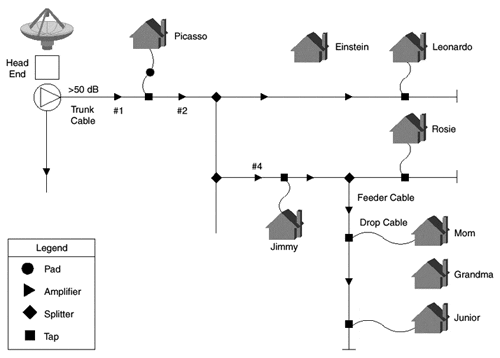Architecture
Figure 3-1 shows a schematic of a cable system that is not upgraded with fiber. Video programming for cable systems is obtained by satellite or microwave at places called head ends. Head ends have facilities to do the following:
Receive programming (for example, from NBC, CBS, and cable networks such as MTV and ESPN)
Convert each channel to the channel frequency desired, scramble channels as needed (for the premium channels)
Combine all the frequencies onto a single, broadband analog channel (frequency division multiplexing)
Broadcast the combined analog stream downstream to subscribers
Downstream traffic is also referred to as forwardtraffic. As of December 1996, there were 11,660 cable head ends in the United States.
The combined downstream video traffic emanates from the head end and is injected into a trunk cable. To provide geographical coverage, splitters divide the traffic at branching points, and the replicated traffic goes into feeder cables that emanate from the trunk cables. Subscribers are connected to the feeder cables or trunk cables with the addition of a drop cable (300 feet of cable or less) and a connector between the drop cable and the feeder, called a tap.
Figure 3.1. Cable System Schematic

Another approach to connecting users is to use long drop runs of low-loss cables (more expensive than normal drop cables) to a central tap, thus eliminating some of the distribution system. This improves reliability and reduces theft of service.
In the home, there is the familiar F-connector, a cylindrical connector with a center pin sticking out, that is plugged in to a set-top box or cable-ready TV or VCR. An F-Connector is a low-cost male and female screw-on connector for RF coaxial cable, consisting of a straight bare center wire (male) or socket (female) conductor and a threaded cap (male) or post (female) for the coaxial cable shield. F-connectors for cable range in styles and costs from very inexpensive press-on connectors to more costly (and reliable) gold plated waterproof crimp-on connectors.
The head end and its connected coaxial cables and subscribers comprise a cable system. The operator of a cable system is a cable operator. Big companies, called multiple system operators (MSOs), are established and, as the name suggests, operate multiple systems. MSOs may own systems that are geographically contiguous or widely dispersed. Geographically contiguous systems offer a greater economic advantage than wide, dispersed systems. MSOs are aggregating their systems into large contiguous regions through mergers and acquisitions. The major MSOs in the United States are AT&T (through its acquisition of Tele-Communications Inc. [TCI] and MediaOne), Time Warner Cable (owned by Time Warner), Cox Cable, Comcast, Cablevision, and Adelphia. Important MSOs in other countries are Canal Plus (France); A2000 (Netherlands); Deutsche Telecom (Germany); and Rogers Cable, Cogeco, Videotron, and Shaw (all in Canada).
Signal strength attenuates by the square root of frequency as it moves through the cables (trunks, feeders, and drops). So, higher frequency signals lose strength faster than lower-frequency signals. This is one reason why programmers desire lower-numbered channels. Signal strength is also attenuated by splitters and taps.
To maintain signal strength, the signals are boosted in the forward path with amplifiers roughly every kilometer. Because higher channels attenuate faster and because the distances over which they must travel can be long, amplification for the higher frequencies might yield excessive power levels for low-frequency channels. So there is a need to equalize power across the transmitted frequency band at the end points to reduce distortion.
To cover a distant site, an amplifier might be turned up high, resulting in too much signal strength and distortion. So, nearby homes need a pad, a passive device that induces attenuation. For example, in Figure 3-1, amplifier 1 is cranked up to provide service to Leonardo, thereby requiring Picasso to have a pad on his drop cable.
The result is a tree and branch topology with the head end as the root and the subscribers as the leaves. It is possible that the farthest subscriber could be 50 to 70 miles from the head end. Splitters and taps are necessary to distribute television signals but have the side effect of weakening signal strength by introducing signal loss at each occurrence.
In Figure 3-1, eight homes are passed by cable, and six are actual subscribers. A home passed is a residence that can be a subscriber with the addition of a drop cable. About 95 percent of all homes in the United States are passed. Einstein and Grandma count as homes passed even though they are not subscribers. The take rate is the ratio of homes that pay for the service to homes passed. In this example, the take rate is 6/8, or 75 percent. As of December 1996, the take rate in the United States was 64.1 percent, according to Nielsen Media Research.
